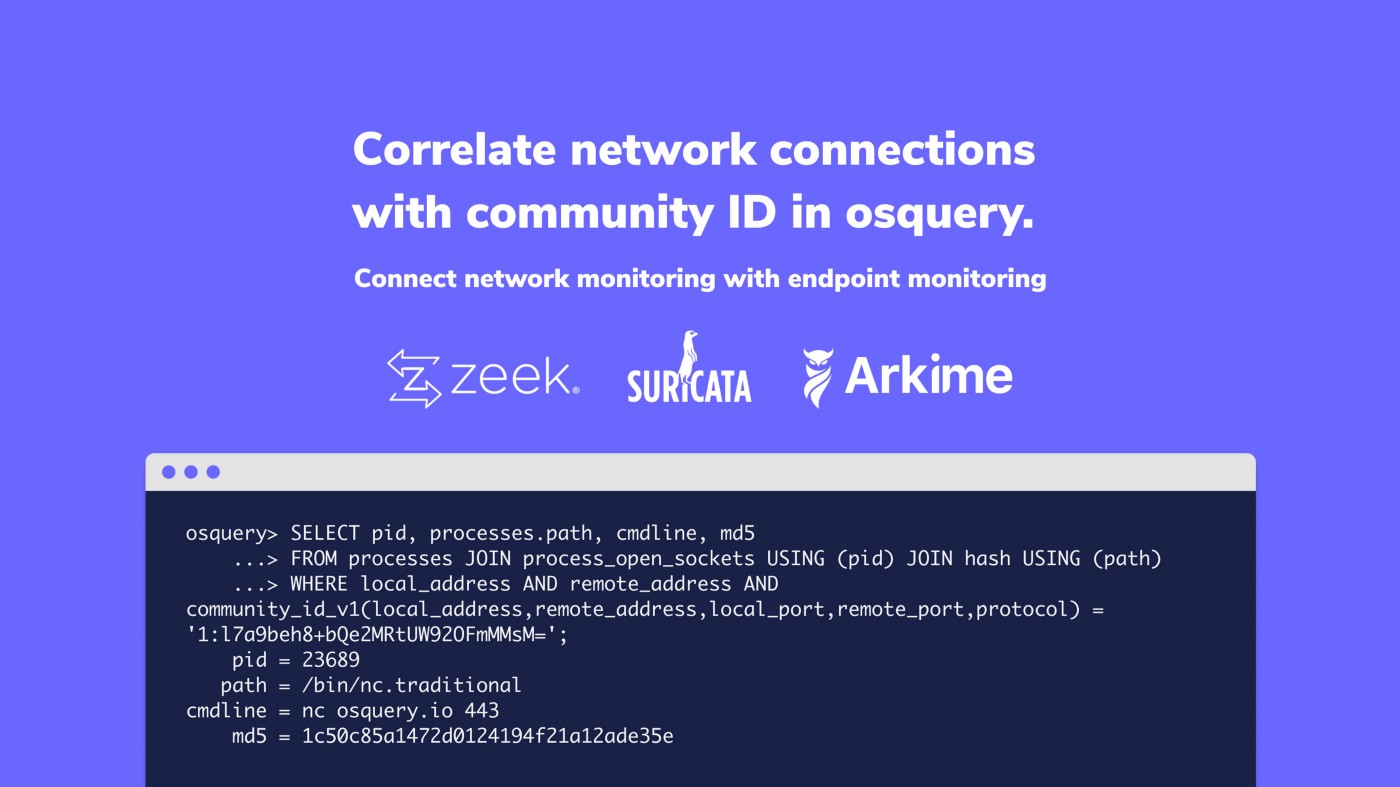Correlate network connections with community ID in osquery.
{{articleSubtitle}}
Zach Wasserman
Correlate network connections with community ID in osquery.
{{articleSubtitle}}
Zach Wasserman
Correlate network connections with community ID in osquery.
Connect network monitoring with endpoint monitoring.

Interested in correlating events from network monitoring tools to host activity? Support for Community ID hashing in osquery allows osquery’s endpoint instrumentation to be easily correlated with that of network monitors such as Zeek. Similar strategies can be used to correlate osquery logs with those from other tools that support Community ID. This includes Arkime (formerly Moloch), Suricata, and more.
Community ID
Community ID is a hash of the network connection parameters that allows a connection to be matched between monitoring solutions that support the hash.
To generate a Community ID, a hash is performed with the source and destination IP addresses and ports, along with the protocol and a seed. The generated hash is deterministic and can be compared across implementing software.
Correlation
How do we use Community ID to correlate the logs between a networking tool and osquery? Consider the following conn.log generated by Zeek:
$ cat /usr/local/zeek/logs/current/conn.log
...
#fields ts uid id.orig_h id.orig_p id.resp_h id.resp_p proto service duration orig_bytes resp_bytes conn_state local_orig local_resp missed_bytes history orig_pkts orig_ip_bytes resp_pkts resp_ip_bytes tunnel_parents community_id
#types time string addr port addr port enum string interval count count string bool bool count string count count count count set[string] string
1582669704.509068 CEmnOh4OZTnzaUHWi 172.17.0.2 47434 192.168.65.1 53 udp dns 0.030783 0 36 SHR T T 0 Cd 0 0 164 - 1:M9OoSr2um69x5G8SikO3S7CVlKk=
1582669709.819653 CVTuEs4iasnpIw8nb7 172.17.0.2 35173 192.168.65.1 53 udp dns 0.004224 0 92 SHR T T 0 Cd 0 0 1120 - 1:1/6GSKCm6A8zk8jXFOEeZKTYccY=
1582669709.844549 CZX3af2jpkfeJzNItb 172.17.0.2 42716 13.227.76.23 443 tcp - 30.017714 0 0 SHR T F 0 ^hCf 0 0 288 - 1:l7a9beh8+bQe2MRtUW92OFmMMsM=
1582669741.641209 CQFgp24cLxMDaBPr03 172.17.0.2 50944 13.227.76.89 443 tcp - 1.691777 0 9653625 SHR T F 0 ^hCadCCCfA 1 406827 9926713 - 1:13GuW4mT6PnRwUi+zetPtsWWD3I=
1582669741.587538 CDvjoz2xAkMs4vbpo8 172.17.0.2 38330 192.168.65.1 53 udp dns 0.033607 0 352 SHR T T 0 Cd 0 0 2408 - 1:6tMXxnnFDfuiCIYTYXXCPMfB3fA=Say that we are interested in the TCP connection between 172.17.0.2:42716 and 13.227.76.23:443. Looking in the last column of the log, we retrieve the Community ID 1:l7a9beh8+bQe2MRtUW92OFmMMsM=.
We can now use the Community ID as the connection to the information available in osquery:
osquery> SELECT community_id_v1(local_address,remote_address,local_port,remote_port,protocol) AS community_id, *
...> FROM processes JOIN process_open_sockets USING (pid)
...> WHERE local_address AND remote_address AND community_id = '1:l7a9beh8+bQe2MRtUW92OFmMMsM=';
community_id = 1:l7a9beh8+bQe2MRtUW92OFmMMsM=
pid = 23689
name = nc
path = /bin/nc.traditional
cmdline = nc osquery.io 443
state = T
cwd = /root
root = /
uid = 0
gid = 0
euid = 0
egid = 0
suid = 0
sgid = 0
on_disk = 1
wired_size = 0
resident_size = 2088000
total_size = 10880000
user_time = 0
system_time = 0
disk_bytes_read = 0
disk_bytes_written = 0
start_time = 1582669708
parent = 1
pgroup = 23689
threads = 1
nice = 0
fd = 3
socket = 138425
family = 2
protocol = 6
local_address = 172.17.0.2
remote_address = 13.227.76.23
local_port = 42716
remote_port = 443
path =
state = CLOSE_WAIT
net_namespace = 4026532309This query provides a great deal more context for the network connection observed in Zeek. We can see what command is running (cmdline), the path to the executable (path), the executing user (uid), the start time of the process (start_time), and much more.
In this case we clearly observe that the network connection is a connection made with the netcat tool to osquery.io.
The data retrieved by osquery can be further extended by joining to additional tables. For example, the following query also retrieves the MD5 hash of the process binary:
osquery> SELECT pid, processes.path, cmdline, md5
...> FROM processes JOIN process_open_sockets USING (pid) JOIN hash USING (path)
...> WHERE local_address AND remote_address AND community_id_v1(local_address,remote_address,local_port,remote_port,protocol) = '1:l7a9beh8+bQe2MRtUW92OFmMMsM=';
pid = 23689
path = /bin/nc.traditional
cmdline = nc osquery.io 443
md5 = 1c50c85a1472d0124194f21a12ade35eExtend the Concept
In the above examples, a live investigation of the network traffic is performed using osqueryi. How can we take advantage of this functionality to perform retroactive analysis?
Queries can be scheduled within osqueryd to log the Community ID of network connections along with the details about the associated process. These logs can be collected in the log aggregation pipeline/SIEM and correlated with the logs from network monitoring. Consider scheduling queries such as:
SELECT *, community_id_v1(local_address,remote_address,local_port,remote_port,protocol) AS community_id
FROM processes JOIN process_open_sockets USING (pid) JOIN hash USING (path)The community_id column can then be used to correlate the events logged by network monitors.
On Linux, the socket_events table may produce additional utility as it captures all socket connections, not only those active at the time of query execution.







